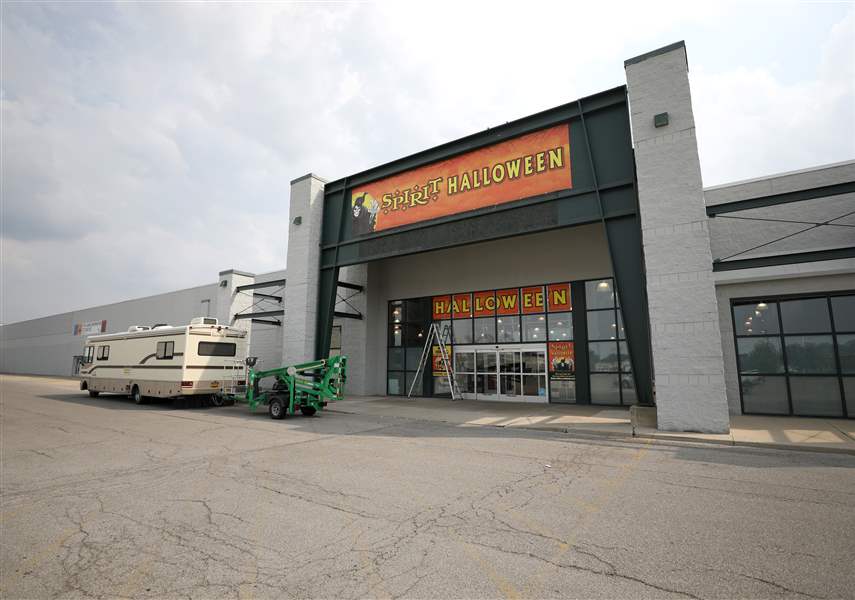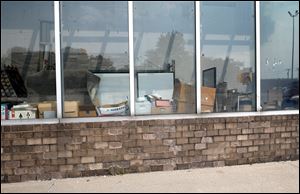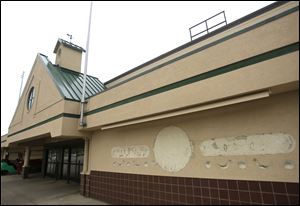
Downsizing leaves vacant big boxes across Toledo
8/18/2018
A vacant store, that was formerly a Dick's Sporting Goods, on Alexis Road in Toledo on August 15. The store is currently being turned into a temporary Spirit Halloween.
The Blade/Kurt Steiss
Buy This Image
Commercial Realtor Pete Shawaker has attended retail conventions in Columbus for 30 years and almost every time the format was the same — dozens of executives from retail chains were present, ready to make deals for vacant space in Ohio’s malls, power centers, and strip centers.
Filling vacancies in Toledo’s inventory of large retail spaces, those of 50,000 square feet or more, was challenging but not impossible with so many retailers looking for new markets to conquer.

Items are stacked up near a front window adjacent to the front entrance of a vacant store, which was formerly a Food Town Market, on 5860 Lewis Avenue in Toledo on August 15.
But in recent years, things have changed dramatically, said Mr. Shawaker of the Reichle Klein Group, a commercial real estate firm in Toledo.
“This year there were only 40 retailers signed up. In a normal year, there could be upwards of 100,” he said.
What’s more, those 100 used to be focused solely on Ohio. Of late, the annual convention sponsored by the International Council of Shopping Centers is still held in Ohio, but now it also includes real estate agents from Western Pennsylvania, Indiana, and West Virginia.
“That’s telling us something — that even though the macro-economy is good, in retail it’s telling us there’s no growth out there. There’s no buying power, and it’s difficult to find an untapped demand,” Mr. Shawaker said.
More critical to Toledo is demand for so-called big box retail space has all but dried up.
Mr. Shawaker was attending the convention with his Reichle Klein colleague, Duke Wheeler, and the two were trying to find tenants for several empty big box stores that they are marketing for clients.
“We were talking about who can fill some of these big boxes. ... We were just looking at our list of potential retailers and we can’t find anyone that needs 80,000 square feet,” Mr. Shawaker said.
The Toledo area has 12 vacant stores ranging from 59,000 square feet to 182,000 square feet.
The list of closed stores includes:
● Food Town at 3314 Secor Rd. and a Food Town/adjacent Value City department store at 5860 Lewis Ave. in Toledo.
● Value City at 2584 Woodville in Northwood.
● Dick’s Sporting Goods at 851 W. Alexis Rd. in Toledo.
● Giant Eagle stores at 6932 W. Central in Sylvania Township and 9570 Fremont Pike in Rossford.
● Kroger at 27386 Carronade Dr. in Perrysburg Township.
● The Andersons at 4701 Talmadge Rd. in Toledo.
● Kroger at 3300 Glendale Ave. in Toledo.
● Sears at 3408 W. Central Ave. in Toledo.
● Kmarts at 1727 W. Alexis in Toledo and 2830 Navarre Ave. in Oregon.
The list will add another 140,000 square feet once Elder-Beerman at 3311 Secor Rd. closes later this month.
Combined, the closed big boxes will total nearly 1.3 million square feet — about the size of Franklin Park Mall.
“Some have been there almost forever it seems like and they may never be occupied in the state that they are in. I can’t think of one that’s got a high probability of use other than the Giant Eagle on U.S. 20 [in Rossford],” said Sam Zyndorf, a commercial real estate agent with the Toledo office of Signature Associates.
“You take the Sears, the Food Towns that are left, the Kmarts. It’s highly unlikely they are going to be used and if they are it’s not going to be retail,” he said.

Remnants of a sign on the closed The Andersons store on Talmadge and Monroe in Sylvania in July, 2017.
Some of them, such as the Food Town on Secor, which has a new owner and is being actively marketed, have been on the market for nearly 15 years with no takers, although the vacant store came close a few times.
But eight sites on the list have been added in just the last three years.
Mr. Zyndorf said their tenants are retailers that have downsized, like Sears and Kmart, gotten out of the Toledo retail market, like Giant Eagle, or gotten out of retail altogether, like The Andersons.
In past years, you could find a new tenant, but retail has evolved, Mr. Zyndorf said.
“You think about big-box development today, who’s out there still looking? You got Costco. Amazon said they’ll build some stores,” he said. “But Macy’s isn’t going to be building new stores. Others are downsizing too.”
Several things account for the increased number of big boxes going dark. Internet retailing has played a part in changing people’s shopping habits.
But Jack Kleinhenz, chief economist for the National Retail Federation, said demographic changes cannot be overlooked.
Population growth is occurring in some areas of the United States, such as the Southeast. But in areas of the Midwest population is declining, reducing the need for previous levels of existing retail.
Also, retail is changing. Some big box stores were built for a different kind of demand, one in which customers could get everything they needed in one trip, the economist said. “Many retailers are now right-sizing in terms of their ability to have the right amount of space for individuals or for households to do their shopping on their terms,” he said.
That means smaller stores, limited onsite inventory, and more distribution centers. Some, like Best Buy, are integrating online shopping with smaller brick-and-mortar stores to attract a new generation of shoppers.
“There’s a lot of changing demographics at work here and we can’t dismiss that as a factor,” Mr. Kleinhenz said.
Experts say while the evolving retail means fewer big boxes, demand is high for so-called junior boxes — stores of 40,000 square feet or less filled by chains such as T.J. Maxx, PetSmart, OfficeMax, and Steinmart.
“Demand for bigger spaces is diminished now. If it’s under 45,000 square feet you’ve got buyers, but it’s just a lot more problematic if you cross that threshold,” said Garrick Brown, a vice president and retail analyst at Cushman & Wakefield, a global real estate firm based in Chicago.
Mr. Brown, who has studied the big-box vacancy problem, said that for anything more than 65,000 square feet, the only active retailer adding stores is Hobby Lobby. “But they won’t go into malls. They only go into power centers,” he said.
Power centers
A power center is a large outdoor shopping mall, such as the Spring Meadows Shopping Center in Holland, which usually includes three or more big box stores, as well as smaller retailers and restaurants.
Meanwhile, the 20,000-square-foot vacancies are in high demand, Mr. Brown said. “Trader Joe’s is going after the 15,000 to 20,000-square-foot locations, and they just keep plugging away. Even traditional grocers are moving away from the 70,000-square-feet stores to smaller stores,” he added.
The lack of retail demand does not mean the Toledo area’s retail dinosaurs will remain empty. Some, like the Sears store, probably will be torn down and cleared.
“The land there is too valuable,” Mr. Zyndorf said.
But others could be subdivided or repurposed.
For example, Mr. Shawaker said he plans to tell one of his clients who owns a vacant big box that it needs to be subdivided. “That’s what I’m going to advise the client, that they need to break it up. That era of big boxes is over.”
Mr. Brown agrees. “Retail is going to evolve more in the next 10 years than it did in the last 40,” he said.
“If it’s Class A space, probably you’re going to be able to fill it with retail space. But down the food chain, the Class Bs have to work harder, and Class C is your dead or dying malls, and frankly, some of those haven’t even hit the radar yet,” he said.
But Mr. Brown said many older big boxes are becoming medical office complexes.
“Retail is in a holistic approach. Maybe you don’t even look at filling [vacant space] with retail anymore. It could be hospitality or multifamily housing,” he said.
“The Mall of America just added two hotels and a half million-square-foot office complex. What they’re finding is office users love an office with creative space. Those workers are driven by the fact they can access cooler nearby amenities,” Mr. Brown said.
Retail mixed with housing, hotels, and health-care facilities “are part and parcel as to what’s going to be the new retail formula,” he said. “It’ll be mixed use as opposed to shopping centers being these monuments to commerce alone.”
Contact Blade Business Writer Jon Chavez at jchavez@theblade.com or 419-724-6128.